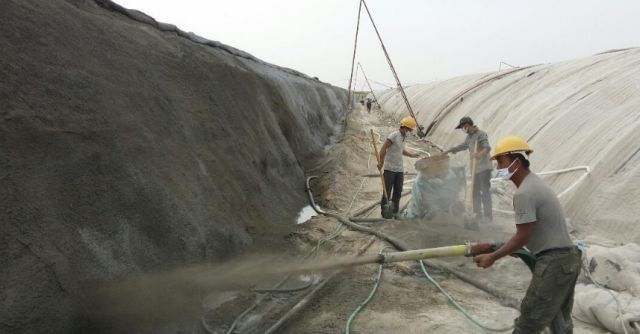Sprayed concrete – what’s special about it?
- Si Shen

- May 2, 2021
- 4 min read
Updated: May 4, 2021
This post is a study note based on various sources rather than professional advice, and may not be reflective of the most up-to-date development. Some of the content of this post has been inspired by Alun Thomas’ book “sprayed concrete lined tunnels”.
The airborne concrete
Normally (and conventionally) concrete is constructed by pouring into place; formwork can help moulding it into the designed shape where needed. There is a another way to getting concrete into place, which is spraying. It is like manually 3D printing concrete into place, as the material is applied layer by layer. Sprayed concrete is preferable where access for establishing formwork or pumping concrete into place is difficult, costly or dangerous. It is frequently used in situations including slope stabilisation, tunnelling, temporary excavation support and concrete repair.
If concrete is like infantries, then sprayed concrete would be like paratroopers, in that it is airborne. Conventional concrete and sprayed concrete both do the same thing when put into position, but get there in different ways.
… Or do they?
Sprayed concrete and ‘conventional’ concrete have subtle differences in their properties, because they are designed with different emphasis born in mind. This blog post will go through how sprayed concrete is different from conventional concrete from a functionality perspective.
The sticky concrete
Sprayed concrete needs to ‘stick’ better than conventional concrete, placing a much greater emphasis on the early strength gain. Sprayed concrete is normally used in situations where concrete needs to get onto a sloped, vertical or even overhead surface, where conventional concrete has great difficulties of dealing with. For this reason, it needs to stick to the substrate immediately and start gaining strength quickly, so that subsequent layers can stick onto the previous layer. For concrete, strength = stickiness. Furthermore, in situations such as tunnelling and excavation support, the concrete sprayed onto place needs to start functioning as a relatively rigid structure as soon as possible, so that construction can proceed at a high rate, not having to wait for the strength gain.
Gelling agents are more frequently used in sprayed concrete, to help concrete stick to the substrate.
Accelerators are more frequently used in sprayed concrete, and normally the default setting. The sooner concrete starts to hydrate, the quicker it gains strength, and the quicker it starts to function as a structural support, at the very least against its self weight.
Cement replacement such as GGBS and PFA is rarer because they slow down the early strength gain, and if used, limited to a small dosage.
High workability
Sprayed concrete has to be more workable (flowable) than conventional concrete, because they need to shoot out of a pipe, splat onto a surface and self-compact into a monolithic piece under the pressure of the spray. To help it do this, sprayed concrete normally has the following differences compared to conventional concrete:
There is typically more water in sprayed concrete (higher water-cement ratio). More water = more fluidity.
The aggregate of sprayed concrete is normally limited to a smaller size (say 10mm), because larger aggregates are harder to pump and more liable to blockages
Plasticisers and superplasticisers are more frequently used in sprayed concrete, to increase workability, without having to add more water. Water lowers the strength of concrete because micro voids will be left after the chemical reaction finishes.
Microsilica is often added, to improve immediate adhesion, reducing the dosage of accelerator, and/or allowing thicker layer of application. It also improves the long term density of the concrete.
Since the mix needs to be highly fluid, stabilisers can be used to improve viscosity, preventing segregation and bleeding.
Designed to be not heavily reinforced
Sprayed concrete and bar reinforcement do not mix well. Conventional bar reinforcement, especially at large diameters, compromises the compaction of sprayed concrete, a phenomenon called ‘shadowing’. The diameter of bar reinforcement is normally limited to 10mm to 16mm, with spacing of 100mm to 150mm, depending on the experience and trial with the specific concrete mix used.
Instead, fibres are more frequently used in sprayed concrete, particularly in safety-critical situations such as tunnel lining, to provide a high degree of ductility in the material. Note that the ductility of fibre reinforcement is typically lower than that of bar reinforcement, although already way better than plain concrete.
Higher degree of time-dependency
As priority is given to early strength gain, the long-term property of sprayed concrete has to give way to certain extent. Due to the higher water content, earlier loading and lower cement-replacement, the shrinkage and creep of sprayed concrete tends to be higher than that of conventional concrete, where other influencing factors are kept the same. Durability and long-term strength is traded out for early strength gain and workability, especially where used as temporary works only.
Nothing inferior
The differences stated above are done in a generic sense. Sprayed concrete is by no means necessarily inferior to conventional concrete, as it all depends on it use. High-spec sprayed concrete can be tailor made to do exactly what conventional concrete can do in terms of structural performance and durability, such as a permanent sprayed tunnel lining. Where used as temporary works only, the specs obviously can be more relaxed for better economy.
Furthermore, this post can be complemented by this previous post on sprayed concrete linked below.


Comments